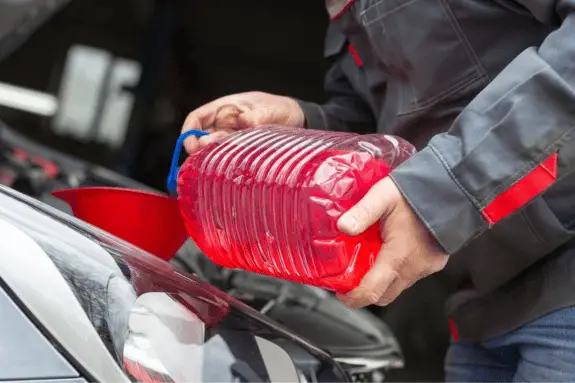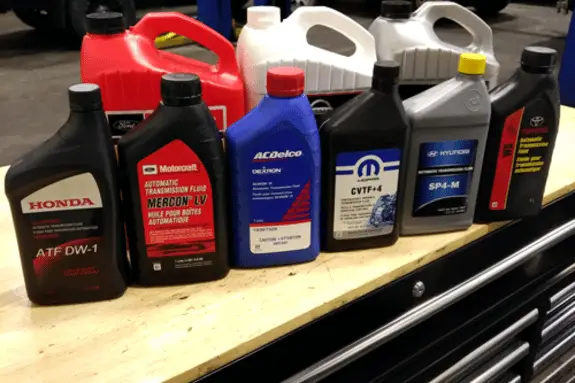Last Updated on August 19, 2023 by Pittalks
When dealing with automobile maintenance, safety should be a paramount concern. One safety aspect that often gets overlooked is the flammability of different automotive fluids.
In this exhaustive guide, we’ll specifically focus on transmission fluid, often referred to as ‘trans fluid’. The primary question that we’re here to address is – “Is trans fluid flammable?“
Let’s delve into the topic and uncover everything there is to know about the flammability of transmission fluid, its properties, and safety precautions.

Is Trans Fluid Flammable?
Well technically no, trans fluid is not flammable! However, there are some important considerations to take because it’s still combustible!
Does that mean it’s going to explode? Well no, not necessarily. It means that it takes a significantly larger amount of heat to create any kind of circumstantial danger as it relates to transmission fluid.
To expand on this, let’s go further into what it means to be “flammable” vs “combustible”.
What Does It Mean to Be Combustible?
Before we answer the primary question, let’s clear up some confusion around the terms ‘flammable’ and ‘combustible’. These terms are often used interchangeably, but they have distinct meanings in the context of fire safety.
A substance is deemed flammable if it can easily ignite and continue to burn. Flammable substances have a low flash point, typically less than 100°F.
On the other hand, a combustible substance requires a higher temperature to ignite, with a flash point above 100°F. While it can still catch fire, it requires more heat to do so compared to a flammable substance.
What’s the Flash Point for Trans Fluid?
The flash point of a liquid is the lowest temperature at which it can vaporize to form an ignitable mixture in air. The flash point is a crucial factor in determining whether a substance is flammable or combustible.
The flash point of transmission fluid typically ranges from 302°F to 383°F. The exact flash point can vary based on the specific formulation and additives used. As this value is above 100°F, transmission fluid is classified as a combustible liquid.
Each trans fluid will have a manufacturer’s declared flash point, but here’s a table giving you a quick overview of the estimated ranges for the flash point of transmission fluid:
| Transmission Fluid | Flash Point Range |
|---|---|
| Automatic Transmission Fluid (ATF) | 170°C (338°F) to 225°C (437°F) |
| Synthetic Transmission Fluid | Above 225°C (437°F) |
| Manual Transmission Fluid | 170°C (338°F) to 225°C (437°F) |

Does Transmission Fluid Burn or Explode?
While transmission fluid is combustible and can catch fire, it is not inherently explosive. It can ignite when it surpasses its flash point and the brake fluid comes in contact with an ignition source.
However, under normal circumstances, the risk of transmission fluid catching fire is relatively low. It usually requires unusual situations like high-impact collisions or substantial leaks for the fluid to come into contact with a sufficiently hot surface and ignite.
It’s crucial to note that while transmission fluid isn’t a primary fire source in a vehicle, it can contribute to the spread of a fire once the temperature surpasses its flash point.
Here’s a scenario in which all the variables perfectly align, particularly a transmission fluid leak and high operating temperatures:
Can Transmission Fluid Boil?
Yes, transmission fluid can boil under specific circumstances, especially in demanding operating conditions or when the transmission system faces extreme heat. Under normal driving conditions, the temperature of the transmission fluid remains well below its boiling point. However, in certain situations, such as towing heavy loads, driving in stop-and-go traffic, or prolonged high-speed driving, the transmission may generate excessive heat, causing the fluid temperature to rise and potentially reach or exceed its boiling point.
What’s The Boiling Point of Transmission Fluid?
The boiling point of transmission fluid typically falls within a temperature range of approximately 175°C (347°F) to 250°C (482°F). However, it’s important to note that this range can vary depending on the specific formulation of the transmission fluid, as well as the prevailing atmospheric pressure. Generally, synthetic transmission fluids tend to have higher boiling points compared to conventional ATF.
Keep in mind that each transmission fluid will have it’s own declared boiling point (per the manufacturer’s packaging. Otherwise, here’s an overview table showing the estimated boiling point range for transmission fluid:
| Transmission Fluid Type | Boiling Point Temperature Range |
|---|---|
| Automatic Transmission Fluid (ATF) | Approximately 175°C (347°F) to 250°C (482°F) |
| Synthetic Transmission Fluid | Above 175°C (347°F) to 250°C (482°F) |
| Manual Transmission Fluid | Approximately 175°C (347°F) to 250°C (482°F) |
Boiling Point Factors
While boiling transmission fluid is very rare, there are a few factors that can lead to this:
Fluid Composition: Different types of transmission fluids, such as conventional ATF, synthetic fluids, or specialized blends, have varying boiling points based on their chemical makeup.
Transmission Design: The design and efficiency of the transmission system can impact how well it dissipates heat, affecting the fluid temperature.
Operating Conditions: Aggressive driving, towing heavy loads, or continuous high-speed driving increase the workload on the transmission, elevating the fluid temperature.
Fluid Level and Quality: Proper fluid level and regular maintenance ensure the fluid’s ability to cool and lubricate the transmission effectively, preventing overheating.
External Cooling Systems: Some vehicles are equipped with external transmission coolers that aid in dissipating heat and lowering the fluid temperature.

How To Properly Store Trans Fluid?
Properly storing transmission fluid is essential to maintain its efficacy and longevity. The recommended storage conditions for transmission fluid are a dry area with temperatures ranging between 50-77°F.
The type of container used for storage also plays a significant role. Metal containers, preferably the fluid’s original packaging, are the best choice. They shield the fluid from UV radiation and other environmental factors that can degrade the fluid’s quality. Glass or plastic containers are not recommended due to their susceptibility to breakage, cracking, and environmental deterioration.
Always ensure that the container is securely sealed to prevent contamination and moisture ingress.
Is Trans Fluid Safe In A Hot Car?
One might wonder if the transmission fluid can pose a fire hazard in a hot car. The answer primarily lies in understanding the operating temperatures of a vehicle’s transmission system.
The temperature of an automatic transmission under normal operation can reach around 195°F. In extreme situations, like pulling a heavy load, the temperature can shoot up beyond 350°F. However, even at these high temperatures, the transmission fluid remains within a non-flammable range due to its high flash point.
Therefore, under regular operating conditions, transmission fluid poses minimal fire risk. However, it’s always crucial to monitor the vehicle’s transmission fluid levels and replace old or dirty fluid to prevent overheating and potential fire hazards.
What’s Auto-Ignition? Can Trans Fluid Do It?
Auto-ignition, or the kindling point of a substance, is the minimum temperature at which it can spontaneously ignite without any external ignition source. A substance’s auto-ignition temperature is influenced by factors such as atmospheric pressure, altitude, and humidity.
Transmission fluid can auto-ignite under specific conditions. When exposed to temperatures over 900°F, like on a heated catalytic converter, transmission fluid can spontaneously ignite. However, in a sealed heated container, the auto-ignition temperature can drop to below 600°F.
FAQs and Related Questions
What Should I Do If My Transmission Fluid Is Burnt?
If your transmission fluid has a burnt smell or appears dark, it might indicate overheating. Overheating can damage your vehicle’s transmission system and should be addressed immediately. In such cases, it’s best to have your vehicle inspected by a professional mechanic. Often, replacing the old fluid with a high-quality transmission fluid can rectify the issue.
How Hot Can Synthetic Transmission Fluid Get?
Synthetic transmission fluid is designed to withstand high temperatures. Most synthetic or synthetic blend transmission fluids can comfortably handle temperatures up to 250°F, providing your vehicle’s transmission with robust protection during long drives, high temperature, and heavy traffic conditions.
What Color Does Burnt Transmission Fluid Have?
A healthy transmission fluid should be clear or slightly pinkish. If the fluid appears deep red or brown, it indicates that it’s old or overheated. In such cases, the vehicle requires immediate maintenance to prevent potential damage to the transmission system.
Can Transmission Oil Cause a Fire?
While it’s rare, transmission oil can indeed cause a fire. When heated, the oil expands and can be forced out through the dipstick tube. If it comes into contact with a hot surface, it can ignite, typically causing a fire within the engine compartment.
Read more from the flammability series:
Is diesel flammable?
Is motor oil flammable?
Is power steering fluid flammable?
Is coolant flammable?
Is hydraulic fluid flammable?
Is brake fluid flammable?
Conclusion
To answer the primary question, yes, transmission fluid is combustible, and under certain conditions, it can catch fire. However, under normal operating conditions, it poses minimal fire risk. Proper storage and maintenance of transmission fluid, coupled with regular vehicle checks, can significantly reduce the potential for any fire hazards.
Always remember, safety should be your primary concern when dealing with vehicle fluids. Being aware of the properties of these fluids, including their flammability or combustibility, can help ensure a safer environment when working on your vehicle.

